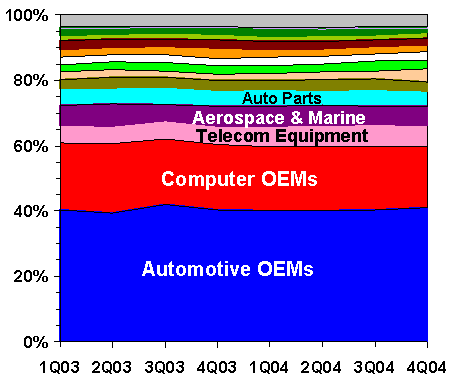Warranty by Industry Sector:
While claims grew by 4.9% to $25.1 billion in 2004, warranty's slice of revenue actually shrank a bit as sales grew faster. In some industry sectors, both dollars and percentages actually fell, but computer and automotive OEMs still process the vast majority of all warranty claims.
American manufacturers paid out $25.1 billion, or 1.8% of their product sales in 2004, to honor their worldwide warranty claims, according to data provided by the manufacturers themselves in their annual reports. However, just a handful of manufacturers accounted for half that total, and only two types of manufactured products together accounted for 60% of the pie.
The universe of manufacturers can be divided up in any of numerous ways. The government slices them up by Standard Industrial Codes (SICs), but those categories seem somewhat antiquated and convoluted (for instance, IBM and HP make "computers and office equipment" while Dell and Apple make "electronic computers."). Unisys is listed as a service company.
Furthermore, the SICs are assigned based on what the companies sell, not what they warrant. So a lumber company that also builds warranted homes is listed under "lumber and wood products (no furniture)" and a carpet and countertop manufacturer is listed under a heading for plastic, rubber, and resin. There are also some weird mixes of unlike companies in the same SIC. A company that makes lawn mowers is in the same SIC as one that makes boat engines and another that makes turbines for power plants.
$1.4 Trillion in Warranted Products?
Numerous manufactured products are not normally covered by express warranties (for instance food, pharmaceuticals, and apparel), nor are most raw materials, minerals, or chemicals. After completing our analysis of 2004 warranty spending, we're going to guesstimate that roughly $1.4 trillion worth of products manufactured in the U.S. are covered by product warranties. That would be something like 12% of the gross national product, plus or minus one or two percent.
What we need is a categorization system for just that 12%. We don't need categories for all manufactured products -- just those that are sold with warranties. We don't need endless categories for financial services, telecommunications services, energy, food, or pharmaceuticals. All we need are a few categories for the major providers of product warranties.
What we've done is to divide the relevant universe of manufacturers into 14 sectors:
- Automotive OEMs -- passenger cars, trucks, buses, RVs, small vehicles
- Computer OEMs -- laptops, desktops, enterprise servers, mainframes
- Telecom Equipment -- phone, cable TV, broadcasting, wireless, Internet
- Aerospace & Marine -- airplanes, avionics, boats, navigation
- Auto Parts Suppliers -- brakes, engines, tires, windows, batteries
- Semiconductors -- chips and the machinery that makes them, also PCBs
- New Homes -- including site-built homes and mobile homes but not RVs
- Building Materials -- roof, floor, carpet, furniture, fixtures, windows, tools
- Medical & Scientific Equipment -- surgical, monitoring, measuring tools
- Data Storage Devices -- hard drives, smart cards, tape, optical
- HVAC/R -- central air, commercial refrigeration, heating and cooling
- PC Peripherals -- printers, monitors, scanners, keyboards
- Major Appliances -- washer, dryer, refrigerator, window AC, stove
- Consumer Electronics -- music, video, cameras, phone handsets, CB, car audio
And then there is the all-purpose "other" category which includes everything from wristwatches to mining equipment. It also includes electrical power turbines, conveyor belts, farming machinery, food processing systems, oil and gas equipment, and other materials handling apparatus that don't easily fit into either the automotive or the building materials categories. And it includes all manner of eyewear, pens, sporting goods, camping equipment, and specialized clothing that doesn't fit into the electronics or appliance categories.
No Splitting Companies
Numerous companies would qualify for two or more categories. However, since they don't divide their warranty expenditures by division or product line, neither will we. Nor will we try to extrapolate from their revenue segmentation what portion of their warranty claims arises from each line of business. Instead, we will place each manufacturer into one and only one category, taking into account what warranted product line dominates their sales totals.
Therefore, we're consigning United Technologies to the aerospace category, in spite of their major presence in HVAC and appliances. American Standard, meanwhile, is going into the HVAC category because of the dominance of Trane, despite the company's presence in plumbing and other lines of business. Honeywell, Brunswick and Textron go into aerospace and marine. Motorola goes into telecommunications equipment. And Eaton goes into auto parts suppliers.
General Electric, which by the way is the sixth largest U.S.-based warranty provider, could easily fit into either of four categories: appliances, aerospace, HVAC, or medical equipment. Whichever category it goes into, it would dominate, being the #1 or #2 warranty provider. However, the company reports that most of the $838 million it reported in 2004 claims arose from sales of electrical power turbines (its "energy" segment). Therefore, we're going to place it in the "other" category, where in fact it accounts for just under 90% of the sector's total.
With all that in mind, here is the warranty track record of these 15 sectors over the past two years. The vertical scale is in percent, while the horizontal scale spans the eight quarters of 2003 and 2004. What's fairly clear is that not much has changed. Automotive and computer OEMs continue to dominate.
Manufacturing Industry Sectors
Warranty Claims as % of Total
2003 - 2004

As the chart suggests, the top two industry sectors -- automotive OEMs and computer OEMs -- account for just about 60% of all warranty claims. Three more sectors -- telecommunications equipment, aerospace and marine, and automotive parts suppliers -- accounted for an additional 17% of all claims. All the companies in the nine other sectors, plus all those companies that didn't fit into a sector, accounted for only 23% combined.
Keep in mind that there aren't a whole lot of companies in the top two sectors. Within the automotive OEM category, there is of course GM and Ford, along with Caterpillar, Deere, Navistar, Paccar, and 30 other manufacturers of everything from motorcycles to fire trucks. Within the computer OEM sector, there is HP, Dell, IBM, Sun, Gateway, Apple, and five others. That's a total of less than 50 companies accounting for more than 60% of all reported warranty claims.
The Big Five of Warranty
It's even more concentrated at the top of these sectors. GM, Ford, HP, Dell, and IBM alone represent $12.57 billion in warranty claims in 2004 -- exactly half the total last year. The other 764 companies that reported some amount of warranty claims and accruals in 2004 accounted for the other half. By the way, the top five accounted for only 35% of the total warranted product sales.
While warranty claims for all 769 manufacturers balanced out to roughly 1.8% of product sales, none of these top five saw their claims rate fall below 2.5%. As a group the top five's combined claims rate is 2.8%. The other 764 companies balance out to around 1.2% of their sales spent on warranty claims.
It's therefore no exaggeration to say that when it comes to warranty, the big passenger car companies and the top computer manufacturers are the major players. They pay out the most and they pay out the greatest share of their product revenue. That's not to say there are no companies with claims rates higher than these five. But there are no other U.S.-based companies paying out more than $1 billion per year to honor warranty claims. We suspect that once foreign currencies are converted, there are perhaps four or five international companies who are also at that level -- DaimlerChrysler, Toyota, Honda, Siemens, and maybe Nokia.
We're not including foreign manufacturers in these calculations, primarily because most don't provide any details about their warranty expenditures to the U.S. Securities and Exchange Commission. We are, however, including all worldwide spending by U.S. manufacturers. So while only 72% of GM's manufactured products are sold in North America, 100% of its worldwide warranty expenses are counted here. And while 32% of Toyota's manufactured products are sold in North America, none of its warranty expenses are included here. There might be a rough balance of trade between warranty imports and exports, or there may not be. We would suggest that in industry sectors such as telecom equipment where there is a net surplus of exports on the U.S. side, there is probably also a net outflow of warranty funds to foreign recipients.
Industry Sectors
Though they say a picture is worth a thousand words, in this case the picture doesn't provide enough detail. At first glance, each of the 15 bands looks to be more or less the same size from start to finish. That is simply not the case. In 2004 major appliance warranty claims were up by more than 5%, and disk drive warranty claims were down by almost 10%. Year over year, computer OEM warranty claims edged up by only $1 million. As a percentage of sales they actually fell.
Therefore, while the picture above catches the eye, the charts below provide the detail. The first chart includes sector totals for warranty claims in 2003 and 2004. The second chart provides the warranty claims rates for each of the sectors over the course of the year. Though the picture above makes it look like nothing much has changed, the numbers below tell a somewhat different story.
Note that for both 2003 and 2004 calculations, the companies in each category are the same. The categories may differ from analyses that have appeared in Warranty Week columns in years past, but they're at least consistent within this article. However, a lot can be changed just by shifting the placement of major warranty providers such as GE, United Technologies, and American Standard from one industry sector to another. In a perfect world, each company would detail their warranty spending by product line. Until that's done, we'll have to be content with less than totally accurate calculations for each industry sector.
Manufacturing Industry Sectors
Warranty Claims in $ Millions
2003 - 2004
| Warranty | Warranty | |
| Claims $m | Claims $m | |
| Industry Sector | 2003 | 2004 |
| Automotive OEMs | $9,630 | $10,148 |
| Computer OEMs | $4,869 | $4,870 |
| Telecom Equip | $1,333 | $1,662 |
| Aerospace & Marine | $1,401 | $1,434 |
| Auto Parts Suppliers | $1,237 | $1,259 |
| Semiconductors | $523 | $694 |
| New Homes | $570 | $668 |
| Building Materials | $663 | $730 |
| Medical & Scientific | $558 | $611 |
| Data Storage | $652 | $589 |
| HVAC/R | $419 | $466 |
| PC Peripherals | $549 | $505 |
| Major Appliances | $436 | $461 |
| Cons Electronics | $106 | $105 |
| Other | $1,016 | $937 |
| All U.S. Mfgs. | $23,964 | $25,139 |
Overall, the total for warranty claims in 2004 was up by $1.175 billion, or 4.9%. But within that total there were some very large increases. Telecom equipment manufacturers saw claims rise by almost 25%. Semiconductor manufacturers saw claims rise by just under 33%. The builders of new homes paid out 17% more in 2004 than they did in 2003.
Spending by automotive OEMs was up by 5.4% in dollar terms. Spending by computer OEMs was up by only 0.02%. Spending by disk drive and PC peripherals manufacturers was actually down from one year to the next.
While the dollar totals are interesting, what means more is the percentage of sales that each dollar total represents. In several sectors, the dollars spent to honor warranty claims increased, but the percentage of revenue spent on warranty decreased. This of course happened because revenue grew faster than costs.
For instance, in the medical and scientific equipment sector, manufacturers spent 9.4% more on claims, but the share this represented dropped from 0.91% to 0.90% of sales. It's rounded off in the chart below so it appears there was no change. But the data does show a notable change in the rates for computer OEMs, data storage, new homes, PC peripherals, and semiconductors.
Manufacturing Industry Sectors
Warranty Claims Rates as % of Sales
2003 - 2004
| Warranty | Warranty | |
| Claims % | Claims % | |
| Industry Sector | 2003 | 2004 |
| Automotive OEMs | 2.6% | 2.5% |
| Computer OEMs | 3.5% | 3.1% |
| Telecom Equip | 1.4% | 1.6% |
| Aerospace & Marine | 1.3% | 1.2% |
| Auto Parts Suppliers | 0.6% | 0.6% |
| Semiconductors | 1.8% | 1.5% |
| New Homes | 0.9% | 0.8% |
| Building Materials | 0.8% | 0.8% |
| Medical & Scientific | 0.9% | 0.9% |
| Data Storage | 2.8% | 2.2% |
| HVAC/R | 1.2% | 1.2% |
| PC Peripherals | 1.7% | 1.4% |
| Major Appliances | 1.9% | 2.3% |
| Cons Electronics | 1.4% | 1.6% |
| Other | 2.5% | 2.7% |
| All U.S. Mfgs. | 1.83% | 1.78% |
The flip side, of course, are the rate increases. Telecom equipment manufacturers saw claims rise by 24.6% in dollar terms, and by 15.7% in terms of the percentage of sales. Major appliances and consumer electronics also saw noticeable increases in percentage terms.
We should note that the consumer electronics category as detailed here does not include warranty spending by any of the European or Asian importers who dominate the industry. Instead, it includes only domestic U.S. manufacturers such as Harman International Industries Inc., Cobra Electronics Corp., and Loud Technologies Inc. who make speakers, microphones, car audio systems, jukeboxes, mixers, and two-way radios.
The consumer electronics category would theoretically include some of the plasma screens and MP3 players sold by the likes of Gateway, Apple, Dell, and HP, but all four are firmly entrenched in the computer OEM category. Were all these warranties included, along with the warranties provided by the importers (not to mention the extended warranties sold by domestic retailers), this would be a very large sector indeed.
| Back to Part One | Go to Part Three |









